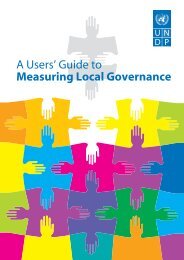planning a governance assessment - United Nations Development ...
planning a governance assessment - United Nations Development ...
planning a governance assessment - United Nations Development ...
Create successful ePaper yourself
Turn your PDF publications into a flip-book with our unique Google optimized e-Paper software.
Micro, macro or both levels?<br />
To assess <strong>governance</strong> properly, the differences between the macro and micro levels should be closely examined. At<br />
the macro level there exist political institutions and at the micro level the experiences, attitudes and beliefs of typical<br />
citizens, in particular the extent to which the political institutions are accepted as legitimate. Many claim that to have higher<br />
levels of democratic <strong>governance</strong>, there must be a fit between these two levels. At the macro level, there should be political<br />
institutions that conform to democratic procedures and the rule of law, and at the micro level, an acceptance by the mass<br />
public, who in a democracy have the power to sanction or remove their leaders. A careful examination of the political<br />
institutions and how they are perceived by the public is needed in a comprehensive <strong>governance</strong> <strong>assessment</strong>.<br />
An index or a scale?<br />
Many of the existing <strong>governance</strong> <strong>assessment</strong> report their results as an index. It is important to understand the differences<br />
between an index and a scale. An index is often made up of many types of data, collected in different ways from different<br />
stakeholders. It is a numerical tool that represents a combination of indicators and information that can be compared over<br />
time.<br />
One of the best known indices is the UNDP Human <strong>Development</strong> Index (HDI). The HDI is a combination of many<br />
different indicators, such as GDP, literacy rates, educational enrollment, life expectancy, and number of telephone lines.<br />
Transparency International’s Corruption Perceptions Idex and the World Bank Institute’s Worldwide Governance Indicators<br />
are also well-known examples of indices used to assess <strong>governance</strong>.<br />
At some point in the development of an index, decisions are made on how much weight each indicator is given. Indicator<br />
weighting is likely to be complicated and subjective. Because of the complexity, the process is often arbitrary, and seldom<br />
transparent or easily understood by typical citizens or even many experts. It also is important to consider the sources and<br />
quality of information used when interpreting an existing index or attempting to construct a new index.<br />
A scale is a set of numerical values assigned to subjects, objects, or behaviours for the purpose of quantifying the measuring<br />
qualities. In contrast to indices, scales are usually one-dimensional and measure only the degree to which an individual or<br />
object possesses the characteristic of interest. Scales usually rely on original data, but it is often possible to use secondary<br />
data to develop a scale. Scales are often created by simply adding up the scores or values of indicators and are usually easy<br />
to understand.<br />
At some point stakeholders must choose to develop or use an index, a scale or both. There are no clear advantages to<br />
either approach concerning costs; it really depends on the situation. Scales may be easier for typical citizens to understand,<br />
but may have more rigorous data requirements and require time and money to develop. Indices can be tricky to construct.<br />
Getting the weighting correct can be difficult and this process can be difficult for typical people to understand. In some<br />
cases, using an index may limit opportunities to disaggregate the results. Finally, these measurement tools require skill and<br />
experience to construct.<br />
Types of <strong>assessment</strong>s<br />
Desk studies are usually conducted by local or external experts such as academics. These <strong>assessment</strong>s may rely on<br />
archival data, administrative data, narrative reports, laws, legal documents and government statistics, as well as the opinions<br />
of key informants. Desk studies often suffer from a lack local context and experience when conducted by external experts.<br />
However, the use of local academics or other experts may rectify this problem. Regardless of whether external or local<br />
experts are used, these studies often only provide the views of a small group of experts. Desk studies are usually costeffective,<br />
especially after the initial round, because many are simply updated versions of previous studies. These studies are<br />
well suited for examining the de jure <strong>governance</strong> situation in a country and may also be useful to better understand the de<br />
facto situations.<br />
Planning a Governance Assessment: A Guide to Approaches, Costs and Benefits<br />
13








![GuÃa del Usuario ] - Governance Assessment Portal](https://img.yumpu.com/44740603/1/190x253/gua-a-del-usuario-governance-assessment-portal.jpg?quality=85)







